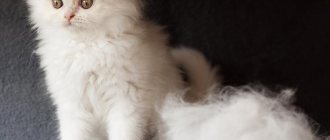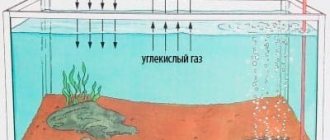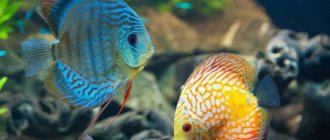Getting to know the plant
The general public is more familiar with Indica Rotala as an aquarium plant than as a weed in rice fields. The grass originated in the tropical reservoirs of Southeast Asia. Grows in shallow waters in weakly flowing water. Clinging to the bottom of the reservoir with a creeping rhizome, it forms dense purple thickets with almost half a meter of erect stems. Small (1 - 2.5 mm) succulent leaves add color to the plant. Shoots above the surface bloom.
In the water column, the leaves are ovoid and elongated; they are arranged oppositely and loosely on the stem. Above the surface they are rounded, thickened, and acquire a characteristic glossy sheen. Pink flowers appear in the leaf axils.
The genus name rotalis is translated from Latin as “having wheels.” It is not in vain that Indica Rotala got its name - it now travels around the world, although the official reason for naming the plant was the whorled arrangement of the leaves.
As an introduced species, Indica Rotala successfully infests the rice plantations of Congo, Italy, and Portugal. It grows in the tropical climate of California and Louisiana. It is also found in the wetlands of subtropical Transcaucasia.
A part of the huge genus of plants Rotala, the aquatic grass Rotala indica, was studied and systematized by the German botanist K.L. Wildenov at the beginning of the 19th century:
| Chapter | Name |
| Kingdom | Plants |
| Family | Derbennikovye |
| Department | Angiosperms |
| Class | Rozoids |
| Squad | Myrtaceae |
| Genus | Rotala |
Since 1960, there has been confusion among aquarists regarding the names of the species. Rotala rotulifolia was often called Indian. They got the true plant in 2009 under the name Ammania “Bonsai”. The error was corrected in 2013.
Features of an aquarium plant
The artificial habitat leaves its mark, giving the plant its own flavor. The bush grows quickly, within a month, but is low to 25 cm. The diameter of the juicy round stem is up to 2 mm. Ideal for small aquariums. New shoots emerge from numerous buds of the rhizome, forming a lush tussock. In the water column, the stems are elongated and pressed tightly against each other; on the water surface they form a rounded shape.
Weak roots and a minimum of absorbed nutrition allow the use of Indian Rotala both rooted and floating.
Rotala does not bloom under water; its decorative appearance is represented by bright leaves. Their color scheme depends on the saturation of light rays: light green, emerald, red-brown, with a pink or purple tint. The expressiveness of grass is indispensable in creating fantastic aquarium compositions.
Botanical description
Pyrola rotundifolia L. 1753. bp. PI 296. — Wintergreen round-leaved
Rast. up to 20 (30) cm high. Long rhizomatous polyphonic. Aboveground pob. at the base with b. m. dense rosettes l. L. 1.5-4.5 cm long. and 1.5-3.5 cm wide, leathery, shiny, partially overwintering, round or broadly oval at the base, as well as at the apex, rounded, rarely slightly heart-shaped, entire-edged or with vague teeth, black. up to 2 times longer layer. Flowering st. ribbed, about half its length. occupies a brush of 5-15 rejected, sometimes drooping colors. Chashel. 3.5-5 mm long., Their ovate-lanceolate ends are bent downwards. Wench. 15-20 mm in diameter, wide open, white or intensely purple, pinkish, with a subtle scent reminiscent of lily of the valley. Lep. 6-10 mm long. and 4-6 mm wide., thickish, round-ovate, obtuse. Tych. at the beginning of flowering they are pressed to the top. side of the crown, then, like the column, deflect downwards. Column 7-10 mm long; r-tse 5-ray, disc-shaped. Boxes 5 mm long. and 8 mm in diameter, flattened-spherical. 2n=46 (Zhukova, Petrovsky, 1971, 1976; Zhukova, 1982).
Editorial: Brown Staurogin
All districts of the SDV, except for the North Kursk. - In forests, bush thickets, in shrub tundras. VI-VII. - General distribution: Heb. h., Caucasus, Zap. and Vost. Sib., Wed. Az.; Scand., Atl. and Wed. Heur., Middle., Mala., Mong., Him., Japan-China. (China), North. Am. — Described from Europe and North. America.
Indica Rotala - jackpot for the aquarium
Indica is valued not only for its exotic hydrophyte, but also for its ability to maintain the biological balance of the biosystem environment. In the Rotala aquarium, Indian serves as a kind of filter, participating in metabolic processes:
- absorbs carbon dioxide;
- produces oxygen;
- neutralizes excess nitrates and phosphates.
The grass is considered a “litmus test”, reacting with the color of its leaves to any changes in water balance.
05:34
Pros and Cons of Long Stem Plants in the Aquarium. Features of keeping Long stems
11:29
My mistakes when growing toninas and syngonanthus. Be careful with organics in the aquarium!!!
02:21:06
Aquarium plants will tell you what they need. Unscientific stream.
Fish like to eat rotala indica. It is better not to use it with those digging the bottom, because, raised from the bottom, the suspension will destroy the plant.
Variations of the species
There are few varieties of Indian Rotala; subspecies differ in the number of leaf blades in the whorl. There are 2, 3 and 4 leaf specimens. The 2-sheet form remains more aesthetically pleasing for a long time. The leaves of this hybrid are large, 2 cm long and about 5 cm wide.
In other variants, the leaves are narrower; due to thickening, the upper leaves shade the lower ones. From lack of light they fall off, leaving the stem bare. There is a way out: place the grass in the background, covering the bare stems with large-leaf plants.
Conditions of detention
Even a novice aquarist can grow an unassuming hydrophyte. If the fish are comfortable in the aquarium, then the grass feels great. Given the origin of the plant, it is preferable to keep Indica Rotala in tropical conditions.
Water environment
In nature, Indica grows in slightly flowing water, so it is enough to replace a quarter of the volume once a week. Weed is more demanding in terms of acidity and hardness. It feels better in neutral or slightly acidic water, pH in the range of 5 – 7, GH 2 – 12°.
No less picky about temperature, yet it is a tropical crop. Maintaining parameters of +24 – 28°C will have a positive effect on her appearance and health. No additional supply of carbon dioxide is required; its concentration in water is sufficient.
Priming
Indica rooted Rotala looks more aesthetically pleasing. Although it is not picky about the composition of the substrate, it is nice if it is neutral and supplemented with a small amount:
- clay;
- peat;
- silt.
Together with pebbles, the thickness of the layer is 5 cm. The presence of silty compounds will provide Indica with long-term nutrition and additional feeding will not be needed.
You can buy soil for aquarium plants ready-made or make it yourself.
Lighting
The saturation of the light rays affects the aesthetics of Rotala. In shaded conditions, the leaves turn pale and the stem becomes elongated, so additional lighting is used. Light the aquarium for up to half a day. Optimal light intensity is 80 – 100 Lm/l. If the plant is comfortable, it actively begins to grow, and the leaves turn red.
Indica Rotala tolerates short-term shading, but excess light radiation turns out to be destructive and threatens the appearance of algae that are dangerous for the grass.
Content
Rotala is a fairly hardy plant that is easy to care for. But in order for it to grow well and luxuriantly and not lose its aesthetic appeal, several important conditions that the maintenance of this herb requires must be observed.
- The water temperature required for plant comfort is quite high. Optimally 24-26 degrees.
- The composition of the medium to which the plant is accustomed is quite soft - no more than 6-7% hardness. In a harsher environment, it will grow slowly and may even die.
- Rotala roundifolia loves fresh water. Cloudy and stagnant liquid leads to its death. In an aquarium where this grass grows, it is necessary to replace at least a quarter of the water volume weekly.
- The plant requires moderately bright lighting. She does not like over-lighting, but the lack of light also has a detrimental effect on the rotal. Daylight hours are optimal for her if they take about half a day. It is most useful to combine cold light with warm light - LED lamps with incandescent lamps. Depending on the light intensity, you should choose where to plant the grass: at the back or front wall.
- This plant absolutely does not combine with blue-green algae. Their proximity leads to the death of the rotala.
In favorable conditions, rotala rotundifolia shows very high growth rates. This makes it extremely suitable for use in a new, newly launched aquarium. The plant will quickly help “launch” the work of the biosystem, serving as a kind of activator of environmental balance.
On the other hand, rapid growth also means additional efforts to maintain the aesthetic appearance of the aquarium. The grass will need to be thinned and cut quite often, removing dead parts and overly dense bushes.
Another useful feature of grass for decoration is its ability to acquire a reddish color when exposed to some excess light. This helps to achieve an interesting visual effect: against the background of the rest of the aquarium greenery, red leaves look contrasting and exotic.
Like many fast-growing aquatic grasses, this variety of rotala ages quickly. This means that you will have to renew the plant by rooting new branches more often than slow-growing herbs. The fact is that the densely leafy upper part of the stems will shade the root part, and its stems will quickly become bare. It is very simple to correct the situation: the bald part of the stem along with the root is removed, and a lush top is planted in its place.
Remember also that the stems of rotundifolia grass are quite fragile. It should not be roughly touched with hands and it is recommended to protect it from active flows - plant it at a distance from the aerator jet.
The nutrition it receives from water is sufficient for this plant. This means that in an aquarium it can be kept either free-floating in the water column or rooted in the ground. However, the separately floating branches of rotala do not look at all as attractive as a lush bush, so the plant is still usually rooted. Keep in mind that Indian rotala produces weak roots. It may be necessary to additionally secure the plant in the ground.
Return to content
Planting, care, reproduction
To get a new Indian Rotala plant, it is enough to cut cuttings with 3–4 internodes and let them float freely on the surface of the water. When roots appear, immediately plant the cutting vertically in the ground, otherwise Indica will stunt growth.
06:32
Indian rotala haircut (rotala indica)
03:39
ROTALA IN THE AQUARIUM. MAINTENANCE AND CARE
03:01
Indian rotala (Rotala indica)
Planting with several stems looks more impressive than a single plant. Even from one cutting, a full-fledged bush is obtained by pinching the top of the shoot. The grass grows quickly; within a month a fluffy tussock appears. Periodic thinning will protect against shade and leaf loss. Once a month, it is enough to cut out the bare stems and leave suitable cuttings for seedlings.
Hardy Lindernia rotundifolia
Lindernia rotundifolia inhabits tropical waters of Sri Lanka, Madagascar, Vietnam, Peru, India and Africa. Due to the fact that this simple and at the same time very pretty representative of the underwater flora grows well and is unpretentious, it will be an excellent solution for beginning aquarists. By the way, it is quite possible to cultivate this plant above water - in this case it is usually kept in covered glass containers on window sills.
Getting to know the plant
The length of the straight stems of Lindernia rotundifolia can reach from thirty to fifty centimeters. They are usually highly branched and can be either ascending or creeping. Light green oval leaves with medium-sized light veins are located crosswise along the entire length of the stems.
Single flowers of Lindernia rotundifolia sit on pedicels 0.7 to 1.5 cm long. Each flower is endowed with five pubescent green sepals and rounded petals. The petals are most often white with small blue-violet spots. And the fruits of the wonderful aquatic inhabitant are small boxes ranging in size from two to three millimeters.
Editorial: Bedocia madagascarica
The root system of Lindernia roundifolia is very weak, and therefore this aquatic beauty is easily pulled out of the ground, so you should handle the attractive green pet very carefully. Lindernia roundifolia got its name from the Strasbourg botanist who lived in the 18th century named Franz Balthasar von Lindern
Lindernia roundifolia received its name from the name of a Strasbourg botanist who lived in the 18th century named Franz Balthasar von Lindern.
How to grow
In acceptable conditions, Lindernia roundifolia is characterized by very rapid growth. Liquid mineral fertilizers periodically added to the water can also enhance its growth to a large extent. As a rule, this aquatic inhabitant takes root well in aquariums.
The water parameters that will ensure full development of Lindernia roundifolia should be as follows: acidity from 5.5 to 8.0, hardness from four to twenty degrees. As for the temperature, it is advisable to try to maintain it in the range from twenty to thirty degrees. The wonderful aquatic creature is systematically fed with mineral fertilizers and carbon dioxide.
Well-silted sand will be the best soil for Lindernia rotundifolia, and when planting this green pet, you need to put a little clay under its roots. By the way, aquarists have noted that, in general, the nutritional value of the soil does not have a significant effect on the quality of growth of the wonderful aquarium resident - she grows equally quickly both in silty soil and in the most ordinary clean sand.
Bright lighting with an intensity of 0.5 to 0.7 W/l is the best solution for the comfort of Lindernia rotundifolia. Fluorescent lamps are perfect for providing additional light.
Reproduction of the beautiful aquarium inhabitant occurs either by dividing the stems or separating the tops and then planting them in another place. As a rule, cuttings are accepted quite quickly and grow very well if they are provided with proper lighting.
Dense thickets formed by Lindernia rotundifolia should be thinned out periodically. This representative of the underwater flora tolerates cutting perfectly, also reacts to transplants without stress, and if you do not root it, but leave it in free swimming, then it forms extremely attractive openwork balls that serve as an excellent shelter for fry.
Lindernia roundifolia planted singly does not have the same decorative interest as specimens growing in groups. But if you plant this aquatic beauty along the side and back walls of the aquarium, it will create an incredibly attractive background and give the aquarium a unique charm. You can also take several cuttings of different lengths and plant them in a group in the form of a ladder in the foreground - they will contrast perfectly with all kinds of large-leaf aquarium plants.
Reviews and advice for beginners
Although Indica Rotala appeared relatively recently among aquarists, it has already caused a lot of controversy. Some consider it a “plant for the lazy,” others consider it a finicky herb. However, their discussions provide invaluable assistance to beginners. Here's what they recommend:
- Large herbal plants with a variety of species require fertilizers, and Indica Rotala is sensitive to copper, boron, and iron content. Before feeding, you need to remove the bushes from the aquarium.
- Choose artificial light in the red-orange range.
- Shoots that escape the water column begin to bloom, while those that have faded lose their decorative effect. They should be pinched at the surface of the water.
- If the Indica leaves appear larger and brighter near the water surface than at the bottom, CO2 should be added.
Beginners need to be careful and careful when using fertilizers - Indica Rotala is very sensitive to excess micro and macroelements.
The unassuming universal hydrophyte Indica Rotala is increasingly interested in landscapers. Not only the decorative and cleansing functions of the grass attract their attention, but also the affordability of the price.



